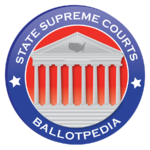Judicial selection in Wisconsin
| Judicial selection in Wisconsin | |
 | |
| Wisconsin Supreme Court | |
| Method: | Nonpartisan election |
| Term: | 10 years |
| Wisconsin Court of Appeals | |
| Method: | Nonpartisan election |
| Term: | 6 years |
| Wisconsin Circuit Courts | |
| Method: | Nonpartisan election |
| Term: | 6 years |
Judicial selection refers to the process used to select judges for courts. At the state level, methods of judicial selection vary substantially in the United States, and in some cases between different court types within a state. There are six primary types of judicial selection: partisan and nonpartisan elections, the Michigan method, assisted appointment, gubernatorial appointment, and legislative elections. To read more about how these selection methods are used across the country, click here.
This article covers how state court judges are selected in Wisconsin, including:
As of April 2023, the selection of state court judges in Wisconsin occurred through nonpartisan elections. At the end of each judge's term, he or she must run for re-election to remain on the court.[1]
Click here to notify us of changes to judicial selection methods in this state.
Wisconsin Supreme Court
- See also: Wisconsin Supreme Court
The seven justices of the Wisconsin Supreme Court are elected in statewide nonpartisan elections. Judges serve ten-year terms, and to remain on the court, they must run for re-election after their term expires. Only one seat may be elected in any year, and more than two candidates for each seat must file to have a primary.[2][3]
Qualifications
To serve on the supreme court, a judge must be:
- licensed to practice law in Wisconsin for a minimum of five years immediately prior to election or appointment[4]
Chief justice
The chief justice of the court is selected by peer vote for a term of two years.
Vacancies
In the event of a vacancy on the court, the governor has the power and duty to appoint an individual to the vacancy. The governor screens judicial applicants using an advisory council on judicial selection. The council recommends three to five candidates to the governor, although the governor is not bound by their recommendations. The appointed justice must then stand for election in the first subsequent year in which no other justice's term expires.[3][2][5]
The map below highlights how vacancies are filled in state supreme courts across the country.
See also
External links
Footnotes
- ↑ 1.0 1.1 1.2 American Judicature Society, "Methods of Judicial Selection: Wisconsin," archived October 3, 2014
- ↑ 2.0 2.1 2.2 2.3 2.4 2.5 National Center for State Courts, "Methods of Judicial Selection," accessed August 12, 2021
- ↑ 3.0 3.1 3.2 3.3 Wisconsin State Legislature, "Wisconsin Constitution," accessed September 19, 2014 (Article VII, Section 4: pg.10) Cite error: Invalid
<ref>tag; name "section4" defined multiple times with different content Cite error: Invalid<ref>tag; name "section4" defined multiple times with different content - ↑ Wisconsin State Legislature, "Wisconsin Constitution," accessed September 19, 2014 (Article VII, Section 24: pg.11)
- ↑ Wisconsin State Legislature, "8.50 - Special elections," accessed April 19, 2023
- ↑ Wisconsin State Legislature, "Wisconsin Constitution," accessed September 19, 2014 (Article VII, Section 24: pg.11)
- ↑ Wisconsin Court System, "Court of Appeals"
- ↑ Wisconsin Court System, "Court of Appeals: Judges," accessed October 27, 2015
- ↑ Wisconsin State Legislature, "Chapter 755 - Municipal Judged," accessed August 12, 2021
- ↑ American Judicature Society, "History of Reform Efforts: Wisconsin," archived April 11, 2011
- ↑ U.S. Courts, "FAQ: Federal Judges," accessed March 26, 2015
- ↑ Milwaukee Journal Sentinel, "Judge dismisses Shirley Abrahamson suit to regain chief justice role," July 31, 2015
- ↑ American Bar Association, "Judicial Selection: The Process of Choosing Judges," accessed August 10, 2021
Federal courts:
Seventh Circuit Court of Appeals • U.S. District Court: Eastern District of Wisconsin, Western District of Wisconsin • U.S. Bankruptcy Court: Eastern District of Wisconsin, Western District of Wisconsin
State courts:
Wisconsin Supreme Court • Wisconsin Court of Appeals • Wisconsin Circuit Courts • Wisconsin Municipal Courts
State resources:
Courts in Wisconsin • Wisconsin judicial elections • Judicial selection in Wisconsin



